In an interval of just 15 days, Brazil lost three of the greatest photojournalists who covered political power in the capital, Brasilia. Dida Sampaio (53), Orlando Brito (72), and Erno Schneider (87) marked an era with iconic photos, which tell the country's history from the mid-twentieth century to the present day, ranging from the military dictatorship to the re-democratization process. As luck would have it, they died of natural causes within a short time.
All three have won important awards from the Brazilian press in recognition of their work, such as the Esso (now extinct) and the Vladimir Herzog. And even international honors, such as the World Press Photo Prize, awarded by the Van Gogh Museum in Holland.
“Political coverage is grueling. There are shifts of hours and hours to get, sometimes, one or two clicks, in increasingly difficult situations… (the three of them) knew how to anticipate where to look. They sensed what would happen in a matter of seconds. The great thing about photojournalism is to show the truth despite appearances in a matter of seconds. If you don’t, you lose,” photojournalist Alcyr Cavalcanti, president of the Brazilian Association of Photo and Film Reporters, told LatAm Journalism Review (LJR).
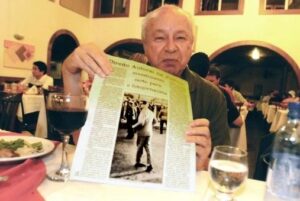
Erno Schneider with his iconic photo: from newspapers to history books. (Photo: Ricardo Chaves/Personal archive)
Featured in several Brazilian history books, the photo by Erno Scheider of then-president Jânio Quadros with his legs crooked, on April 21, 1961, is unforgettable for many Brazilians. It always comes up when the name of the former president is mentioned. More than the curiosity of the position in which Jânio Quadros was photographed, the image symbolized a confused representative full of contradictions, in the midst of a meeting with the president of Argentina, Arturo Frondizi, on the border between the two countries.
"While Jânio was going to meet Frondizi on the bridge, in the middle of the bridge, he decided to walk. He was walking, I was following him from the side. Suddenly, there was a riot, a very large riot. Jânio got a fright and turned around. At the time, I saw that he was all weird, all crooked. I felt like I had a different photo. Then I clicked. It was only one shot," Erno Schneider told the program Fantástico, on TV Globo, in a 2002 interview.

'Government Without Direction.' President Jânio Quadros with crooked feet. (Credit: Erno Schnider)
Just four months after being captured by Schneider's lens, Jânio resigned as president, presiding over a term that lasted about eight months. The iconic photo earned the photographer and the Jornal do Brasil, the news outlet for which he worked at the time, the 1962 Esso Photography Prize.
A gaucho from the city of Feliz, the “German,” as he was known by his friends, died on March 8, aged 87, after sustaining a fall at home. In addition to working at Jornal do Brasil, he also worked at the newspaper O Clarim, in Rio Grande do Sul, was head of the photography department at Correio da Manhã, and was a photo editor at the newspaper O Globo.
“Photojournalism lost a reference point, but also a kind human being, who taught many others. He leaves a big void, but we are grateful for his legacy. He was one of Brazil’s greatest,” Rodrigo Ziebell, president of the Association of Photographic and Cinematographic Reporters of Rio Grande do Sul (Arfoc-RS), said in a note.
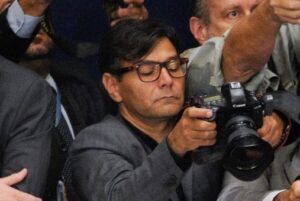
Dida Sampaio in action at the National Congress. (Edilson Rodrigues/Agência Senado)
Francisco de Assis Sampaio, from Ceará, or just Dida Sampaio, 53, suffered a stroke on Feb. 25. He leaves behind his wife, Ana, and their children Raíssa, Felipe, and Gabriela. After stints at Jornal de Brasília and Correio Braziliense, he arrived at the newspaper O Estado de S.Paulo in 1994. There, he stood out for his coverage of authorities in Brasilia, including being awarded the ExxonMobil Award (formerly Esso, the most traditional award of the Brazilian press) of Photography 2015.
The winning image captured a bicycle ride by then-president Dilma Rousseff at the moment when the accusation of “fiscal pedaling,” which would be the basis for her impeachment process in 2016. “Fiscal pedaling” is an unofficial accounting technique in which the government temporarily uses money from state-owned banks without declaring a loan. The photo composition also includes a banner in the background that reads "Lava Jato”—the same name as the Federal Police operation that exposed corruption schemes and led to several politicians being sent to prison.
“That photo had it all. There were several factors that led to this. He was lucky, but he also had a journalistic nose. These definitive photos are insane. A great photojournalist also runs after the news,” Cavalcanti said.
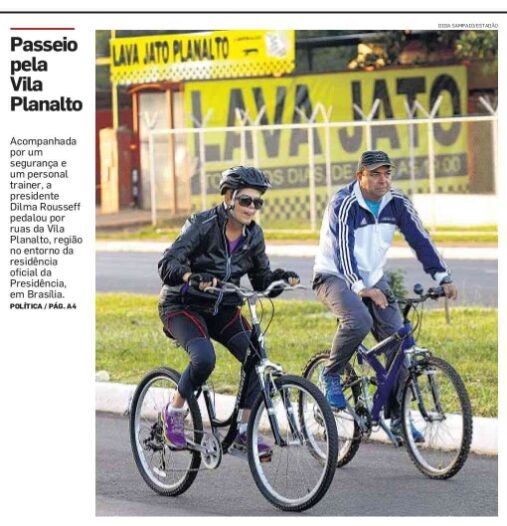
Former president Dilma Roussef rides a bike in front of a car wash in Brasília. This photo won the 60th and last edition of the Esso Prize, which was the most important in Brazilian journalism. (Credit: Dida Sampaio/Estado de S.Paulo)
Sampaio, meanwhile, went beyond the coverage of political leaders. In the same year, he won the Esso de Fotografia, he also won the Southeast Regional category, for the special Favela Amazônia, in partnership with reporter Leonencio Nossa. The work told the story of the advance of drug trafficking, militias, and organized land crime in the Amazon Rainforest.
“Much more than a tireless hunter of scoops, Dida sought a record of living history. Thus, he sought to report a daily life that was always troubled, dramatic, contradictory, as well as tender and simple,” wrote journalists Leonencio Nossa and Andreza Matais in the newspaper Estadão.
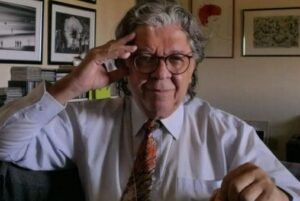
In 56 years of career, Orlando Brito covered 15 presidents of Brazil. (Credit: personal instagram account)
After winning the Abril Photography Prize — there were 11 in all — Orlando Brito was considered “hours Concours,” in a class of his own. The amount of trophies accumulated and the moniker applied to him speaks of a photojournalist who was relevant across generations and remained at the top, influencing a multitude of professionals.
In 1979, he was crowned the first Brazilian to win the World Press Photo Prize, the most renowned in world photojournalism, for a sequence of photos of a military exercise he published at O Globo newspaper, where he worked at the time. The photos show two military personnel falling from a zip line. At the time, the authoritarian regime led by the Armed Forces was nearing its end.
A native of the Minas Gerais state, Brito died on March 11, at the age of 72, due to bowel surgery complications. He is survived by a daughter, Carolina, and two grandchildren, Theo and Thomas.
After starting his career as a laboratory technician at Última Hora, in Brasília, Brito worked as a photojournalist or editor in some of the most prestigious Brazilian news outlets, such as the newspaper O Globo, the magazine Veja, the Jornal do Brasil, and the magazine Caras―the latter featured his photos on 113 covers between 1982 and 1998. In the final phase of his career, he became an independent professional and founded the Obrito News agency.
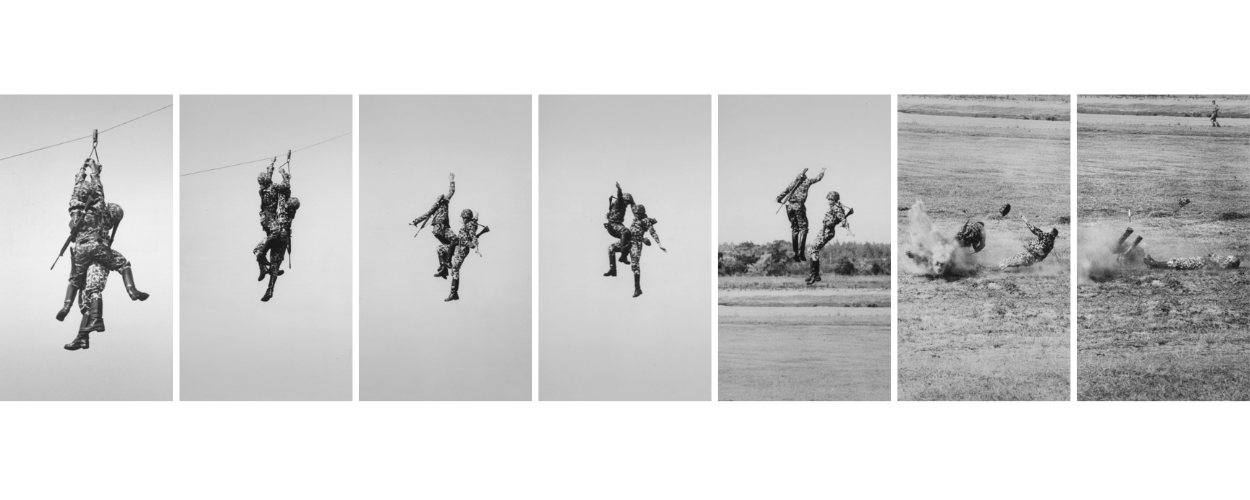
'Fatal Mission'. The sequence shows soldiers in training falling, at a time when the dictatorship was weakening. (Credit: Orlando Brito)
“Brito's dimension as a witness and visual biographer of power in Brazil is unparalleled—in quality, quantity, or longevity. To each of the 15 presidents of the Republic (and their respective entourages) observed almost daily since 1964, Brito brought a unique tenacity,” wrote journalist Dorrit Harazim in O Globo. “He was so familiar with the figures from Brasilia that he knew how to catch even some stifled mood swings. Nothing escaped him, nor did he shy away from the most sleepy official agendas.”
*Cover photo: Pedro França/Agência Senado